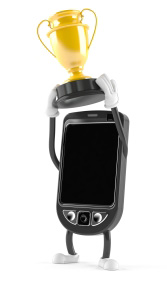 You simply cannot ignore the continuing rise in popularity of smartphones and consumers’ seemingly insatiable appetite for the mobile web. According to the Office of National Statistics (ONS), almost half of UK Internet users are going online via mobile phone data connections and the most rapid growth is among younger people, where 71 per cent of Internet-connected 16 to 24 year olds uses mobiles.
You simply cannot ignore the continuing rise in popularity of smartphones and consumers’ seemingly insatiable appetite for the mobile web. According to the Office of National Statistics (ONS), almost half of UK Internet users are going online via mobile phone data connections and the most rapid growth is among younger people, where 71 per cent of Internet-connected 16 to 24 year olds uses mobiles.
But more importantly, we have a relationship with our mobile device. It may not seem obvious, but look at the evidence. We take it everywhere with us – most of us with it permanently attached to our hand. It’s guaranteed that the two things most people grab when they leave their house is a set of keys and a mobile device – usually before we have even thought about our wallet or purse. Then the panic sets in if we think we’ve lost it.
As a result, for digital marketers the mobile phone is simply the perfect vehicle to put timely promotional information literally under the noses of consumers to get superior response rates. But as most marketers know, there are key considerations that are critical to the level of success this form of direct communication can deliver.
Addressing the challenges
Nobody can deny that running effective direct marketing campaigns on the mobile Internet is tricky. You only have to consider the form factor of mobile devices to see the obvious challenges – the size of the screen creates all sorts of issues from a display point of view and the speed of Internet access can impact delivery of the message.
However, these challenges are easily overcome and when done correctly, far higher conversion rates are achieved using mobile over traditional digital direct marketing techniques like email. From a well-timed SMS reminder about a forthcoming sale to a time-limited special offer, which leads consumers directly to a mobile optimised website, these activities are delivering twice the conversion rate than standard marketing initiatives.
Some of the opportunities
An added advantage of mobile is the huge opportunities it offers for geo-location targeting. If your GPS-enabled device can prevent you from getting lost, just think what it can do for your marketing messages.
Location-based marketing offers the ability to send geographic-specific marketing messages relevant to a consumer’s location. Mobile phone operator O2 is using location-based marketing as a means of deepening its engagement with customers by extending its O2 Priority scheme through a location-based strategy. Its Priority Moments initiative will deliver rewards and experiences to customers that will help them save money. This degree of brand relevancy, timeliness and personal tailoring vastly lifts the engagement and response rates compared to other channels.
What is exciting is that what is possible today is really just the beginning – imagine tomorrow’s world of possibilities. Take Near Field Communications (NFC), a form of Radio Frequency Identification (RFID). NFC has been talked about for nearly a decade – but we’re only now seeing the fruits of technology trials and innovation that have been happening behind the scenes. NFC enables a brand to send a message to a mobile device when its owner walks past or comes close to a specific spot, whether that is in a train station, airport, shopping centre or supermarket. That message can be an exclusive promotion or a QR code offering a shopper an instant discount on a specific product.
Furthermore, although it has been talked about for a while, one application that has pushed NFC into the spotlight lately is as an enabler of the ‘mobile wallet’. We will finally start to see the rise of the mobile as a digital wallet, allowing us to pay for goods and services as well as send and receive funds to and from our mobile. This can produce almost instant returns on well-targeted marketing as consumers are prompted to buy, and can do so immediately.
Businesses should not under-estimate the power of the tablet either. Tablets were predicted to be one of the top-selling Christmas gifts last year and as such, present huge opportunities. Industry analyst, Gartner predicts that tablet computers will see an explosion in sales over the next four years, selling 60 per cent as many units as PCs by 2015. Plus, Apple’s iPad will have over half the market by then.
Finally the launch of 4G, imminent in many parts of the world, will provide a significant increase in mobile data speeds of up to 1GB per second and this will transform the consumption of media on mobile devices. All good news for marketers, who will be able to target consumers more efficiently, more often, more dynamically and quicker than they’ve ever been able to before via a mobile device.





